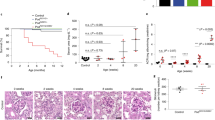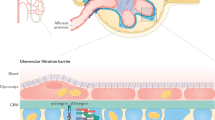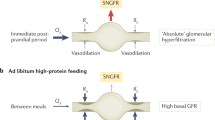Abstract
Human kidneys produce more than 4 million litres of virtually protein-free primary urine in a lifetime. In healthy individuals, the sieving process is accomplished by the glomerular filter without the smallest sign of clogging, even in old age. How nature accomplishes this extraordinary task is a mystery, but unravelling the functioning of the glomerular filter is important. The basic principles that govern glomerular filtration are probably also true for peripheral filtering by fenestrated capillaries. In addition, understanding the sieving process is a prerequisite to understanding the pathogenesis of proteinuria (that is, the leakage of plasma proteins into the urine). Proteinuria is the hallmark of glomerular disease and a major risk factor for systemic cardiovascular complications, a fact that emphasizes the relationship between the glomerular and peripheral filtering capillaries. In this Review, we briefly summarize the major models that have been proposed for the mechanisms of glomerular filtration and discuss their strengths and limitations. A special emphasis is placed on the 'electrokinetic model' that we have proposed, a model that could potentially resolve many of the seemingly strange characteristics of the glomerular filtration barrier.
Key Points
-
The functioning of the glomerular filter is still not completely understood
-
The glomerular filter is an excellent model system for filtering capillaries
-
Several models for glomerular filtration have been proposed and have made major contributions to our understanding of glomerular filtration
-
The electrokinetic model proposes that a local electrical field is established across the glomerular filter by filtration (that is, 'streaming potential'); this electrical field prevents plasma proteins from entering or crossing the glomerular filter
-
The electrokinetic model can potentially provide mechanistic explanations to several as yet unresolved characteristics of the glomerular filtration barrier (GFB)
-
A large body of experimental data has been published that is compatible with the notion of a notable streaming potential across the GFB, but more studies are needed
This is a preview of subscription content, access via your institution
Access options
Subscribe to this journal
Receive 12 print issues and online access
$209.00 per year
only $17.42 per issue
Buy this article
- Purchase on Springer Link
- Instant access to full article PDF
Prices may be subject to local taxes which are calculated during checkout







Similar content being viewed by others
References
Shea, S. M. & Morrison, A. B. A stereological study of the glomerular filter in the rat. Morphometry of the slit diaphragm and basement membrane. J. Cell. Biol. 67, 436–443 (1975).
Matsushita, K. et al. Association of estimated glomerular filtration rate and albuminuria with all-cause and cardiovascular mortality in general population cohorts: a collaborative meta-analysis. Lancet 375, 2073–2081 (2010).
Blouch, K. et al. Molecular configuration and glomerular size selectivity in healthy and nephrotic humans. Am. J. Physiol. 273, F430–F437 (1997).
Oliver, J. D. 3rd et al. Proteinuria and impaired glomerular permselectivity in uninephrectomized fawn-hooded rats. Am. J. Physiol. 267, F917–F925 (1994).
Jeansson, M. & Haraldsson, B. Glomerular size and charge selectivity in the mouse after exposure to glucosaminoglycan-degrading enzymes. J. Am. Soc. Nephrol. 14, 1756–1765 (2003).
Lund, U. et al. Glomerular filtration rate dependence of sieving of albumin and some neutral proteins in rat kidneys. Am. J. Physiol. Renal Physiol. 284, F1226–F1234 (2003).
Haraldsson, B., Nystrom, J. & Deen, W. M. Properties of the glomerular barrier and mechanisms of proteinuria. Physiol. Rev. 88, 451–487 (2008).
Eppel, G. A. et al. The return of glomerular-filtered albumin to the rat renal vein. Kidney Int. 55, 1861–1870 (1999).
Russo, L. M. et al. The normal kidney filters nephrotic levels of albumin retrieved by proximal tubule cells: retrieval is disrupted in nephrotic states. Kidney Int. 71, 504–513 (2007).
Comper, W. D., Hilliard, L. M., Nikolic-Paterson, D. J. & Russo, L. M. Disease-dependent mechanisms of albuminuria. Am. J. Physiol. Renal Physiol. 295, F1589–F1600 (2008).
Comper, W. D. & Russo, L. M. The glomerular filter: an imperfect barrier is required for perfect renal function. Curr. Opin. Nephrol. Hypertens. 18, 336–342 (2009).
Norden, A. G. et al. Glomerular protein sieving and implications for renal failure in Fanconi syndrome. Kidney Int. 60, 1885–1892 (2001).
Weyer, K. et al. Mouse model of proximal tubule endocytic dysfunction. Nephrol. Dial. Transplant. 26, 3446–3451 (2011).
Boute, N. et al. NPHS2, encoding the glomerular protein podocin, is mutated in autosomal recessive steroid-resistant nephrotic syndrome. Nat. Genet. 24, 349–354 (2000).
Hausmann, R., Grepl, M., Knecht, V. & Moeller, M. J. The glomerular filtration barrier function: new concepts. Curr. Opin. Nephrol. Hypertens. 21, 441–449 (2012).
Hausmann, R. et al. Electrical forces determine glomerular permeability. J. Am. Soc. Nephrol. 21, 2053–2058 (2010).
Delgado, A. V., Gonzalez-Caballero, F., Hunter, R. J., Koopal, L. K. & Lyklema, J. Measurement and interpretation of electrokinetic phenomena. Pure Appl. Chem. 77, 1753–1805 (2005).
Reuss, F. in Selected Works on Electricity (ed. Gos) 159–168 (1808).
Seaman, G. V., Vassar, P. S. & Kendall, M. J. Calcium ion binding to blood cell surfaces. Experientia 25, 1259–1260 (1969).
Gribbon, P. M., O'Hare, D., Parker, K. H. & Winlove, C. P. Investigation of the endothelial cell glycocalyx using electrophoresis. Electro-Magnetobiol. 13, 137–146 (1994).
Ferrell, N. J. et al. Effects of pressure and electrical charge on macromolecular transport across bovine lens basement membrane. Biophys. J. (in press).
Salmon, A. H., Neal, C. R. & Harper, S. J. New aspects of glomerular filtration barrier structure and function: five layers (at least) not three. Curr. Opin. Nephrol. Hypertens. 18, 197–205 (2009).
Ryan, G. B. & Karnovsky, M. J. Distribution of endogenous albumin in the rat glomerulus: role of hemodynamic factors in glomerular barrier function. Kidney Int. 9, 36–45 (1976).
Robinson, R. R., Lecocq, F. R., Phillippi, P. J. & Glenn, W. G. Fixed and reproducible orthostatic proteinuria. III. Effect of induced renal hemodynamic alterations upon urinary protein excretion. J. Clin. Invest. 42, 100–110 (1963).
Rennke, H. G. & Venkatachalam, M. A. Glomerular permeability: in vivo tracer studies with polyanionic and polycationic ferritins. Kidney Int. 11, 44–53 (1977).
Farquhar, M. G., Wissig, S. L. & Palade, G. E. Glomerular permeability. I. Ferritin transfer across the normal glomerular capillary wall. J. Exp. Med. 113, 47–66 (1961).
Fujigaki, Y., Nagase, M., Kojima, K., Yamamoto, T. & Hishida, A. Glomerular handling of immune complex in the acute phase of active in situ immune complex glomerulonephritis employing cationized ferritin in rats. Ultrastructural localization of immune complex, complements and inflammatory cells. Virchows Arch. 431, 53–61 (1997).
James, J. A. & Ashworth, C. T. Some features of glomerular filtration and permeability revealed by electron microscopy after intraperitoneal injection of dextran in rats. Am. J. Pathol. 38, 515–525 (1961).
Lewis, E. J., Schwartz, M. M., Pauli, B. U. & Sharon, Z. Endocytosis: a property of the glomerular visceral epithelial cell. Nephron 22, 91–96 (1978).
Bohrer, M. P. et al. Permselectivity of the glomerular capillary wall. Facilitated filtration of circulating polycations. J. Clin. Invest. 61, 72–78 (1978).
Bolton, G. R., Deen, W. M. & Daniels, B. S. Assessment of the charge selectivity of glomerular basement membrane using Ficoll sulfate. Am. J. Physiol. 274, F889–F896 (1998).
Daniels, B. S. Increased albumin permeability in vitro following alterations of glomerular charge is mediated by the cells of the filtration barrier. J. Lab. Clin. Med. 124, 224–230 (1994).
Harvey, S. J. et al. Disruption of glomerular basement membrane charge through podocyte-specific mutation of agrin does not alter glomerular permselectivity. Am. J. Pathol. 171, 139–152 (2007).
Miner, J. H. Glomerular basement membrane composition and the filtration barrier. Pediatr. Nephrol. 26, 1413–1417 (2011).
Goldberg, S., Harvey, S. J., Cunningham, J., Tryggvason, K. & Miner, J. H. Glomerular filtration is normal in the absence of both agrin and perlecan-heparan sulfate from the glomerular basement membrane. Nephrol. Dial. Transplant. 24, 2044–2051 (2009).
Sorensson, J., Ohlson, M. & Haraldsson, B. A quantitative analysis of the glomerular charge barrier in the rat. Am. J. Physiol. Renal Physiol. 280, F646–F656 (2001).
Farquhar, M. G. & Palade, G. E. Glomerular permeability. II. Ferritin transfer across the glomerular capillary wall in nephrotic rats. J. Exp. Med. 114, 699–716 (1961).
Rennke, H. G., Cotran, R. S. & Venkatachalam, M. A. Role of molecular charge in glomerular permeability. Tracer studies with cationized ferritins. J. Cell. Biol. 67, 638–646 (1975).
Brenner, B. M., Troy, J. L. & Daugharty, T. M. The dynamics of glomerular ultrafiltration in the rat. J. Clin. Invest. 50, 1776–1780 (1971).
Farquhar, M. G. Editorial: The primary glomerular filtration barrier--basement membrane or epithelial slits? Kidney Int. 8, 197–211 (1975).
Jarad, G. & Miner, J. H. Update on the glomerular filtration barrier. Curr. Opin. Nephrol. Hypertens. 18, 226–232 (2009).
Tryggvason, K. & Wartiovaara, J. How does the kidney filter plasma? Physiology (Bethesda) 20, 96–101 (2005).
Rodewald, R. & Karnovsky, M. J. Porous substructure of the glomerular slit diaphragm in the rat and mouse. J. Cell. Biol. 60, 423–433 (1974).
Wartiovaara, J. et al. Nephrin strands contribute to a porous slit diaphragm scaffold as revealed by electron tomography. J. Clin. Invest. 114, 1475–1483 (2004).
Gagliardini, E., Conti, S., Benigni, A., Remuzzi, G. & Remuzzi, A. Imaging of the porous ultrastructure of the glomerular epithelial filtration slit. J. Am. Soc. Nephrol. 21, 2081–2089 (2010).
Karnovsky, M. J. & Ryan, G. B. Substructure of the glomerular slit diaphragm in freeze-fractured normal rat kidney. J. Cell. Biol. 65, 233–236 (1975).
Ohno, S., Hora, K., Furukawa, T. & Oguchi, H. Ultrastructural study of the glomerular slit diaphragm in fresh unfixed kidneys by a quick-freezing method. Virchows Arch. B Cell. Pathol. Incl. Mol. Pathol. 61, 351–358 (1992).
Akilesh, S. et al. Podocytes use FcRn to clear IgG from the glomerular basement membrane. Proc. Natl Acad. Sci. USA 105, 967–972 (2008).
Chang, R. L. et al. Permselectivity of the glomerular capillary wall to macromolecules. II. Experimental studies in rats using neutral dextran. Biophys. J. 15, 887–906 (1975).
Rippe, C., Asgeirsson, D., Venturoli, D., Rippe, A. & Rippe, B. Effects of glomerular filtration rate on Ficoll sieving coefficients (theta) in rats. Kidney Int. 69, 1326–1332 (2006).
Fujigaki, Y. et al. Intra-GBM site of the functional filtration barrier for endogenous proteins in rats. Kidney Int. 43, 567–574 (1993).
Russo, P. A. & Bendayan, M. Distribution of endogenous albumin in the glomerular wall of proteinuric patients. Am. J. Pathol. 137, 1481–1490 (1990).
Menzel, S. & Moeller, M. J. Role of the podocyte in proteinuria. Pediatr. Nephrol. 26, 1775–1780 (2010).
Daniels, B. S., Hauser, E. B., Deen, W. M. & Hostetter, T. H. Glomerular basement membrane: in vitro studies of water and protein permeability. Am. J. Physiol. 262, F919–F926 (1992).
Deen, W. M., Lazzara, M. J. & Myers, B. D. Structural determinants of glomerular permeability. Am. J. Physiol. Renal Physiol. 281, F579–F596 (2001).
Fissell, W. H. et al. Solute partitioning and filtration by extracellular matrices. Am. J. Physiol. Renal Physiol. 297, F1092–F1100 (2009).
Jeansson, M. & Haraldsson, B. Morphological and functional evidence for an important role of the endothelial cell glycocalyx in the glomerular barrier. Am. J. Physiol. Renal Physiol. 290, F111–F116 (2006).
Ballermann, B. J. & Stan, R. V. Resolved: capillary endothelium is a major contributor to the glomerular filtration barrier. J. Am. Soc. Nephrol. 18, 2432–2438 (2007).
Sugimoto, H. et al. Neutralization of circulating vascular endothelial growth factor (VEGF) by anti-VEGF antibodies and soluble VEGF receptor 1 (sFlt-1) induces proteinuria. J. Biol. Chem. 278, 12605–12608 (2003).
van den Berg, J. G., van den Bergh Weerman, M. A., Assmann, K. J., Weening, J. J. & Florquin, S. Podocyte foot process effacement is not correlated with the level of proteinuria in human glomerulopathies. Kidney Int. 66, 1901–1906 (2004).
Eremina, V. et al. VEGF inhibition and renal thrombotic microangiopathy. N. Engl. J. Med. 358, 1129–1136 (2008).
Maynard, S., Epstein, F. H. & Karumanchi, S. A. Preeclampsia and angiogenic imbalance. Annu. Rev. Med. 59, 61–78 (2008).
Maynard, S. E. et al. Excess placental soluble fms-like tyrosine kinase 1 (sFlt1) may contribute to endothelial dysfunction, hypertension, and proteinuria in preeclampsia. J. Clin. Invest. 111, 649–658 (2003).
Stillman, I. E. & Karumanchi, S. A. The glomerular injury of preeclampsia. J. Am. Soc. Nephrol. 18, 2281–2284 (2007).
Venkatesha, S. et al. Soluble endoglin contributes to the pathogenesis of preeclampsia. Nat. Med. 12, 642–649 (2006).
Gelberg, H., Healy, L., Whiteley, H., Miller, L. A. & Vimr, E. In vivo enzymatic removal of alpha 2→6-linked sialic acid from the glomerular filtration barrier results in podocyte charge alteration and glomerular injury. Lab. Invest. 74, 907–920 (1996).
Galeano, B. et al. Mutation in the key enzyme of sialic acid biosynthesis causes severe glomerular proteinuria and is rescued by N-acetylmannosamine. J. Clin. Invest. 117, 1585–1594 (2007).
Rostgaard, J. & Qvortrup, K. Sieve plugs in fenestrae of glomerular capillaries--site of the filtration barrier? Cells Tissues Organs 170, 132–138 (2002).
Vink, H. & Duling, B. R. Identification of distinct luminal domains for macromolecules, erythrocytes, and leukocytes within mammalian capillaries. Circ. Res. 79, 581–589 (1996).
Lindahl, P. et al. Paracrine PDGF-B/PDGF-Rbeta signaling controls mesangial cell development in kidney glomeruli. Development 125, 3313–3322 (1998).
Hakroush, S. et al. Effects of increased renal tubular vascular endothelial growth factor (VEGF) on fibrosis, cyst formation, and glomerular disease. Am. J. Pathol. 175, 1883–1895 (2009).
Pappenheimer, J. R., Renkin, E. M. & Borrero, L. M. Filtration, diffusion and molecular sieving through peripheral capillary membranes; a contribution to the pore theory of capillary permeability. Am. J. Physiol. 167, 13–46 (1951).
Rippe, B. & Haraldsson, B. Transport of macromolecules across microvascular walls: the two-pore theory. Physiol. Rev. 74, 163–219 (1994).
Dechadilok, P. & Deen, W. M. Hindrance factors for diffusion and convection in pores. Ind. Engin. Chem. Res. 45, 6953–6959 (2006).
Booth, J. W. & Lumsden, C. J. Explaining glomerular pores with fiber matrices. A visualization study based on computer modeling. Biophys. J. 64, 1727–1734 (1993).
Ohlson, M., Sorensson, J. & Haraldsson, B. A gel-membrane model of glomerular charge and size selectivity in series. Am. J. Physiol. Renal Physiol. 280, F396–F405 (2001).
Smithies, O. Why the kidney glomerulus does not clog: a gel permeation/diffusion hypothesis of renal function. Proc. Natl Acad. Sci. USA 100, 4108–4113 (2003).
Wolgast, M. & Persson, A. E. The gel hypothesis applied to the rat renal capillary membranes: a review. Acta Physiol. (Oxf.) 202, 617–628 (2011).
Shikata, K., Makino, H., Ichiyasu, A. & Ota, Z. Three-dimensional meshwork structure of glomerular basement membrane revealed by chemical treatment. J. Electron Microsc. (Tokyo) 39, 182–185 (1990).
Yamasaki, Y. et al. Three-dimensional architecture of rat glomerular basement membrane by ultra-high resolution scanning electron microscopy. Acta Med. Okayama 44, 333–335 (1990).
Acknowledgements
For reasons of clarity, many important details for all models had to be omitted from this Review. In addition, we have tried to phrase the major statements in such a way that makes them rather short and easily understandable, although again, this endeavour might have resulted in insufficient acknowledgement of the huge amount of intellectual and physical work that has been invested into the development of these models. The authors' work is supported by a Boost Fund OPBo45 of the Excellence Initiative by the German Federal and State Governments (DFG), the NephCure Foundation (F001), the German Ministry for Science and Education (BMBF, 01 GN 0804), TP17 SFB/Transregio 57 of the DFG and a START grant by the Medical Faculty of the RWTH Aachen. M. J. Moeller is a member of the SFB/Transregio 57 DFG consortium “Mechanisms of organ fibrosis”.
Author information
Authors and Affiliations
Contributions
M. J. Moeller and V. Tenten researched data for article, contributed to the discussion of content, and reviewed/edited the manuscript before submission. M. J. Moeller wrote the article.
Corresponding author
Ethics declarations
Competing interests
The authors declare no competing financial interests.
Rights and permissions
About this article
Cite this article
Moeller, M., Tenten, V. Renal albumin filtration: alternative models to the standard physical barriers. Nat Rev Nephrol 9, 266–277 (2013). https://doi.org/10.1038/nrneph.2013.58
Published:
Issue Date:
DOI: https://doi.org/10.1038/nrneph.2013.58
This article is cited by
-
The Potential of Albuminuria as a Biomarker of Diabetic Complications
Cardiovascular Drugs and Therapy (2021)
-
A step forward in understanding glomerular filtration
Nature Reviews Nephrology (2020)
-
A molecular mechanism explaining albuminuria in kidney disease
Nature Metabolism (2020)
-
Transport of neutral IgG2 versus anionic IgG4 in PD: implications on the electrokinetic model
BMC Nephrology (2018)
-
Analysis of extracellular mRNA in human urine reveals splice variant biomarkers of muscular dystrophies
Nature Communications (2018)



